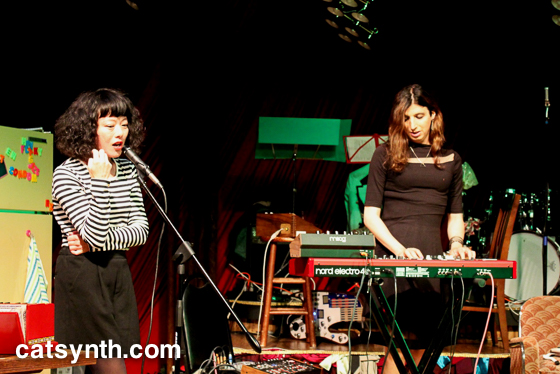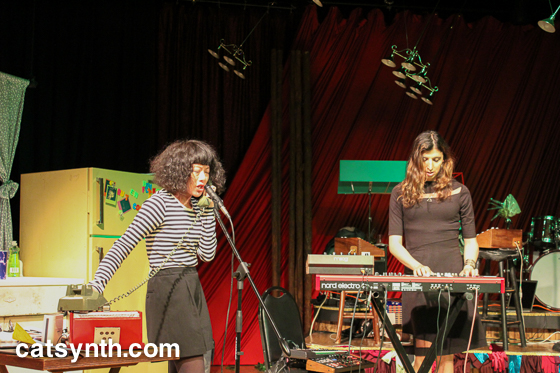I recently reported on my performance with Tania Chen at Spectrum in New York. However, this was not the first of our New York collaborations. A few days earlier we debuted our set at The Brick Theater in Brooklyn.
First up that evening was our friend Nick Dimopoulos as SMOMID, which is also the name of his invented musical instrument.

The SMOMID is a “Strong Modeling Midi Device” that allowed him to control multiple synthesizers and sequencers. His performance was highly dynamic and uses a lot of familiar performance idioms from the guitar, but in the service of a very different musical style that included fast electronic drum runs and other rhythmic patterns. Overall it was an intense and visual performance.
Then it was time for us to take the stage! We started quietly and a bit tentatively with Tania on melodica and myself on keyboard and synthesizer. As with the Spectrum gig, the principle instruments for me were a Nord Electro and a DSI Prophet 12 (for some reason the Moog Mother-32 wasn’t working that night). After a bit of the sound became thicker and more animated. And then we moved to the central part of our performance: two pop-style songs, the first of which was called “Cheezy Love Song.”

The second was a decidedly more melancholy song called “I Still Love You”, with a darker tone provided by the P12 beneath Tania’s singing. From here we segued directly into another experimental electro-acoustic improvisation that showcased the variety of sounds and objects at our disposal.

Our final piece was a cover of the Jackson 5’s “I Want You Back”, which was of course a lot of fun and allowed me to exercise my pop and jazz keyboard skills. Overall, it was a good first performance, but we did learn a lot of things that we used to make Spectrum a few days later a great performance.
One feature of performing at The Brick is that it is a theater. Indeed, there was a play being staged that week, and all the sets had to accommodate the stage set. But it did make for a fun and unusual setting for the music, and in particular we took advantage of some of it within our performance.

The final set featured Teerapat Parnmongkol performing live ambient electronics along with live electronic video.

The music was reminiscent of electronic dance music in a club setting, but it did go off in other directions with noise hits, breaks in the rhythm and more. In the darkened space, however, one’s attention was squarely drawn to the video.
Overall it was a great show and we here happy to share the bill with these other artists. I would also like to extend a thank you to The Brick Theater and to Craig Flanagin for hosting us and making sure things ran smoothly. Hopefully I will be performing in Brooklyn again soon.

 On Saturday, I went a couple of very different performances in various neighborhoods of Brooklyn, ranging from poetry reading and performance art to experimental jazz and pop. At
On Saturday, I went a couple of very different performances in various neighborhoods of Brooklyn, ranging from poetry reading and performance art to experimental jazz and pop. At  At the Music Hall of Williamsburg, I saw a show featuring the Toronto-based band
At the Music Hall of Williamsburg, I saw a show featuring the Toronto-based band